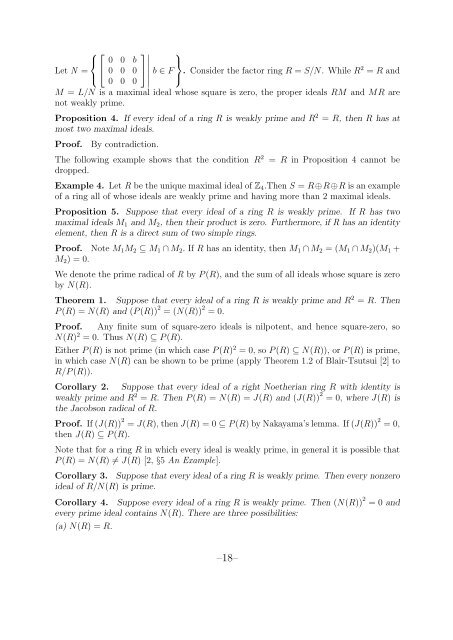Yasuyuki Hirano, Edward Poon and Hisaya Tsutsui
Yasuyuki Hirano, Edward Poon and Hisaya Tsutsui
Yasuyuki Hirano, Edward Poon and Hisaya Tsutsui
You also want an ePaper? Increase the reach of your titles
YUMPU automatically turns print PDFs into web optimized ePapers that Google loves.
⎧⎡<br />
⎨<br />
Let N = ⎣ 0 0 b<br />
⎤<br />
⎫ ⎬<br />
0 0 0 ⎦<br />
⎩<br />
0 0 0 ∣ b ∈ F ⎭ . Consider the factor ring R = S/N. While R2 = R <strong>and</strong><br />
M = L/N is a maximal ideal whose square is zero, the proper ideals RM <strong>and</strong> MR are<br />
not weakly prime.<br />
Proposition 4. If every ideal of a ring R is weakly prime <strong>and</strong> R 2 = R, then R has at<br />
most two maximal ideals.<br />
Proof.<br />
By contradiction.<br />
The following example shows that the condition R 2 = R in Proposition 4 cannot be<br />
dropped.<br />
Example 4. Let R be the unique maximal ideal of Z 4 .Then S = R⊕R⊕R is an example<br />
of a ring all of whose ideals are weakly prime <strong>and</strong> having more than 2 maximal ideals.<br />
Proposition 5. Suppose that every ideal of a ring R is weakly prime. If R has two<br />
maximal ideals M 1 <strong>and</strong> M 2 , then their product is zero. Furthermore, if R has an identity<br />
element, then R is a direct sum of two simple rings.<br />
Proof. Note M 1 M 2 ⊆ M 1 ∩ M 2 . If R has an identity, then M 1 ∩ M 2 = (M 1 ∩ M 2 )(M 1 +<br />
M 2 ) = 0.<br />
We denote the prime radical of R by P (R), <strong>and</strong> the sum of all ideals whose square is zero<br />
by N(R).<br />
Theorem 1. Suppose that every ideal of a ring R is weakly prime <strong>and</strong> R 2 = R. Then<br />
P (R) = N(R) <strong>and</strong> (P (R)) 2 = (N(R)) 2 = 0.<br />
Proof. Any finite sum of square-zero ideals is nilpotent, <strong>and</strong> hence square-zero, so<br />
N(R) 2 = 0. Thus N(R) ⊆ P (R).<br />
Either P (R) is not prime (in which case P (R) 2 = 0, so P (R) ⊆ N(R)), or P (R) is prime,<br />
in which case N(R) can be shown to be prime (apply Theorem 1.2 of Blair-<strong>Tsutsui</strong> [2] to<br />
R/P (R)).<br />
Corollary 2. Suppose that every ideal of a right Noetherian ring R with identity is<br />
weakly prime <strong>and</strong> R 2 = R. Then P (R) = N(R) = J(R) <strong>and</strong> (J(R)) 2 = 0, where J(R) is<br />
the Jacobson radical of R.<br />
Proof. If (J(R)) 2 = J(R), then J(R) = 0 ⊆ P (R) by Nakayama’s lemma. If (J(R)) 2 = 0,<br />
then J(R) ⊆ P (R).<br />
Note that for a ring R in which every ideal is weakly prime, in general it is possible that<br />
P (R) = N(R) ≠ J(R) [2, §5 An Example].<br />
Corollary 3. Suppose that every ideal of a ring R is weakly prime. Then every nonzero<br />
ideal of R/N(R) is prime.<br />
Corollary 4. Suppose every ideal of a ring R is weakly prime. Then (N(R)) 2 = 0 <strong>and</strong><br />
every prime ideal contains N(R). There are three possibilities:<br />
(a) N(R) = R.<br />
–18–















